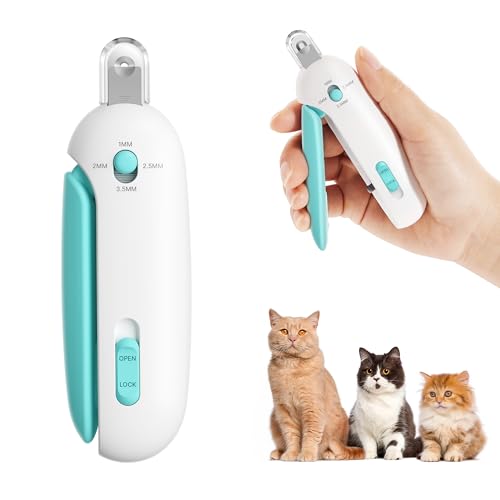The Fascination with Nail Files
Do you ever wonder why your cat seems to have an inexplicable love for nail files? It may seem odd at first, but there are actually a few reasons why your feline friend is so fascinated by these grooming tools.
Sensory Stimulation
Cats have highly sensitive sensory systems, and nail files provide a unique texture and sound that can be incredibly stimulating for them. The rough surface of the file feels similar to the texture of tree bark or rough surfaces that cats encounter in their natural environment. Additionally, the sound of their claws scratching against the file can be satisfying and soothing for them.
Scent Marking
As you may know, cats have scent glands in their paws. When they scratch on a nail file, they leave behind their unique scent as a way of marking territory. It’s their way of saying, “This is mine!” So, when your cat spends quality time with your nail file, they’re not just entertaining themselves, they’re leaving their signature scent as well.
Grooming and Maintenance
Cats are meticulous groomers, and they use their tongues and teeth to clean their fur regularly. While it may seem strange, your cat may mistake the nail file for a grooming tool. The rough surface of the file may mimic the texture of their tongue, providing them with a satisfying grooming sensation. It’s their way of keeping themselves well-groomed even when you’re not around to help.
Remember, not every cat is obsessed with nail files, but if your feline friend can’t resist the allure, now you have a better understanding of why. So, the next time you spot your cat sharpening their claws on your trusty nail file, let them enjoy their little indulgence. It’s just one of the many quirks that make cats so uniquely lovable!
Here are some quick facts:
- Cats are fascinated by the texture and sound of nail files.
- They use nail files as a way to mark their territory.
- Some cats may mistake nail files for grooming tools.
No need for a conclusion here, as we’ll seamlessly transition to the next section.
Understanding Your Cat’s Behavior
As a cat lover, it’s important to understand the reasons behind your cat’s fascination with nail files. Here are a few insights into your furry friend’s behavior:
Sensory Stimulation: Cats are naturally drawn to rough surfaces. The texture and sound of nail files provide sensory stimulation that mimics the rough surfaces they encounter in their natural environment. It’s like their very own mini adventure!
Claiming Territory: Cats have scent glands in their paws, and scratching a nail file allows them to mark their territory. This is their way of saying, “Hey, this is mine!” So, next time you see your cat rubbing against the nail file, it’s not just playful behavior but also a way for them to leave their unique scent behind.
Mistaken Identity: Sometimes, cats may mistake nail files for grooming tools. The rough surface of the files mimics the texture of their tongue, making them believe it’s an unconventional way to groom themselves. It’s a bit like when you try using a spoon as a comb – imaginative but not quite right!
Understanding these behaviors helps us appreciate our feline friends even more. They have their own unique ways of navigating the world around them. So, the next time you find your cat mesmerized by a nail file, remember that it’s simply their natural instincts at play.
No conclusion paragraph/sentence.
The Sensation of Scratching
As a cat lover, you may have noticed your furry friend’s fascination with nail files. But have you ever wondered why they love them so much? Let’s dive into the world of a cat’s sensory experience to understand this quirky behavior.
Cats are naturally drawn to the sensation of scratching. It’s more than just a way to keep their claws in check – it’s an instinctual need. When they scratch, it provides them with a satisfying tactile experience. The rough surface of a nail file mimics the textures they would encounter in their natural environment, such as tree bark or rough rocks. They find it stimulating and gratifying.
Not only does scratching feel good for cats, but it also serves practical purposes. By scratching, cats leave behind visual and olfactory marks. The rough texture of a nail file allows them to leave their scent on it, marking their territory. So when your cat scratches your nail file, they’re claiming it as their own in a way.
But there’s another intriguing aspect to this behavior. Cats may mistake nail files for grooming tools, and here’s why – a cat’s tongue is covered in tiny hook-like structures called papillae. These papillae provide a rough texture that helps them clean their fur effectively. Surprisingly, the texture of a nail file bears some resemblance to their tongue. So when they come across a nail file, they might think it’s a handy tool to groom themselves.
Understanding these fascinating behaviors can deepen your appreciation for your feline friend. So the next time you catch your cat happily scratching away at your nail file, remember that it’s a sensory experience they find irresistible. Embrace their quirks and provide them with appropriate scratching surfaces to keep them satisfied and your furniture intact.
The Texture and Sound Appeal
When it comes to nail files, it’s not just the shape that cats find intriguing. It’s the texture and sound that really capture their attention.
1. Sensory Stimulation: Cats are naturally drawn to textures that provide sensory stimulation. The rough surface of a nail file mimics the rough surfaces they would encounter in their natural environment, such as trees or other objects with rough bark.
2. Marking Territory: Scratching is another important behavior for cats. It allows them to leave visual and olfactory marks and claim the nail file as their territory. So, when they scratch on a nail file, they leave behind their scent, telling other cats, “This is mine!”
3. Mistaking it for Grooming: Cats are meticulous groomers, and their tongues have tiny hook-like structures called papillae. Interestingly, the texture of a nail file resembles their tongue, which may explain why some cats mistake it for a grooming tool. It’s like they’re trying to groom themselves with something that feels familiar.
Tips for Encouraging Healthy Scratching Habits
If your cat is obsessed with nail files, it’s important to redirect their scratching habits to more appropriate options. Follow these tips to encourage healthy scratching habits for your feline friend:
- Provide scratching posts: Invest in a sturdy, vertical scratching post that is tall enough for your cat to fully stretch its body. Place it in an easily accessible and frequented area of your home.
- Choose the right material: Cats have preferences when it comes to scratching surfaces. Experiment with different materials, such as sisal, cardboard, or carpet, to see what your cat enjoys the most.
- Make it enticing: To attract your cat to the scratching post, sprinkle it with a bit of catnip or use a pheromone spray specifically designed to attract cats to scratching surfaces.
- Distract with toys: Place interactive toys near the scratching post to distract your cat from the nail file. Toys with feathers, bells, or catnip inside can be particularly appealing.
- Provide alternatives: Offer your cat alternative scratching options, such as horizontal scratching pads or cardboard scratchers. Some cats prefer these options over vertical posts.
- Positive reinforcement: Whenever you catch your cat using the appropriate scratching surface, praise and reward them with a treat or a gentle petting session. Positive reinforcement helps your cat understand that they are doing something right.
- Trim their nails: Regular nail trims can reduce the need for excessive scratching. Consult with your veterinarian or a professional groomer for proper nail-trimming techniques.
Conclusion
By following these tips, you can help encourage healthy scratching habits in your cat and minimize their interest in nail files. Providing a sturdy scratching post in a convenient location and experimenting with different materials will help you find what your cat enjoys. Adding catnip or pheromone spray to the scratching post, as well as placing interactive toys nearby, can make it even more enticing for your cat. Offering alternative scratching options and using positive reinforcement when your cat uses the appropriate surface will help redirect their attention away from nail files. Remember, regular nail trims can also reduce the need for excessive scratching. By implementing these strategies, you can ensure that your cat’s scratching needs are met in a way that is both enjoyable for them and keeps your furniture safe.
Frequently Asked Questions
Q: How can I encourage healthy scratching habits in my cat?
A: Provide a sturdy scratching post in an easily accessible area and experiment with different materials until you find one your cat enjoys. Make the scratching post enticing by using catnip or pheromone spray and place interactive toys nearby to distract the cat. Offer alternative scratching options and provide positive reinforcement when the cat uses the appropriate surface. Regular nail trims can also help reduce excessive scratching.
Q: Where should I place the scratching post?
A: Place the scratching post in an easily accessible area, preferably near where your cat spends most of its time. Make sure it is in a location where your cat feels comfortable and safe. Avoid putting it near their food or litter box, as they prefer to have separate areas for different activities.
Q: What materials should the scratching post be made of?
A: Experiment with different materials to find the one your cat enjoys. Common options include sisal rope, carpet, and corrugated cardboard. Some cats prefer different textures, so it’s important to try a few options to determine what your cat prefers.
Q: How can I make the scratching post enticing for my cat?
A: You can make the scratching post more enticing by using catnip or a pheromone spray designed to attract cats to the post. Sprinkle some catnip on the post or spray it with the pheromone spray to make it more appealing to your cat.
Q: What should I do if my cat still scratches inappropriately?
A: If your cat continues to scratch inappropriately, provide alternative scratching options such as cardboard scratchers or horizontal scratching pads. Encourage your cat to use these alternatives by placing them near areas where inappropriate scratching occurs. Additionally, redirect your cat’s attention to appropriate scratching surfaces and provide positive reinforcement when your cat uses them.
Q: Will regular nail trims help reduce excessive scratching?
A: Yes, regular nail trims can help reduce the need for excessive scratching. Keeping your cat’s nails trimmed can lessen the damage caused by scratching and reduce the cat’s motivation to scratch excessively. Make sure to use proper nail trimming techniques or consult a veterinarian to avoid causing any harm to your cat.

















